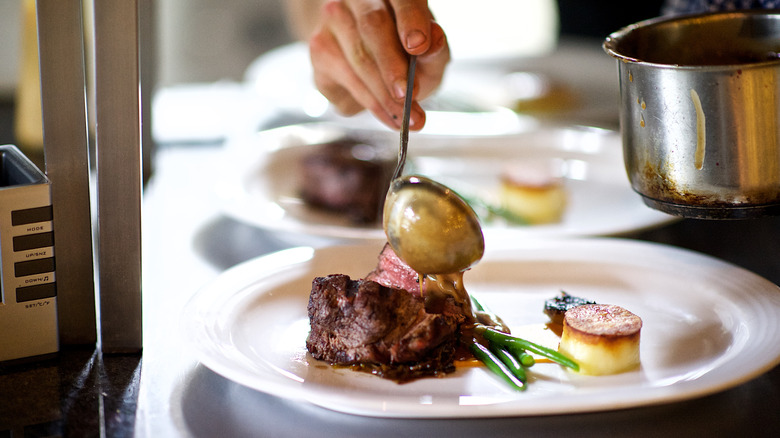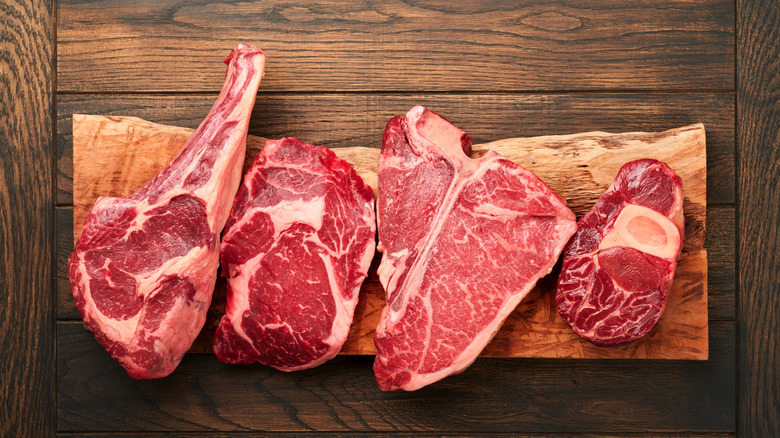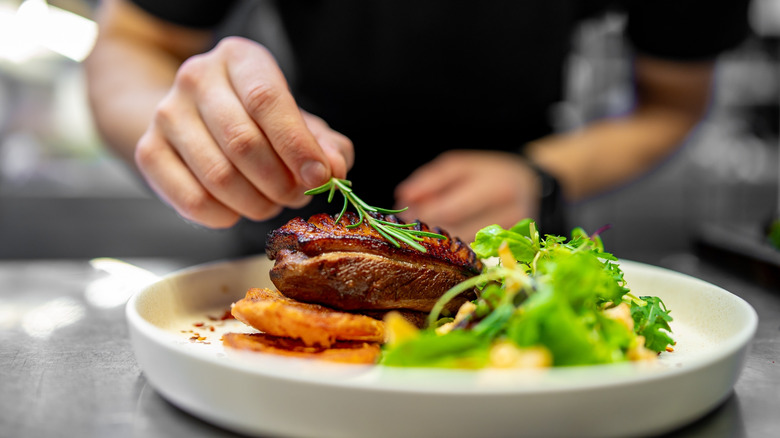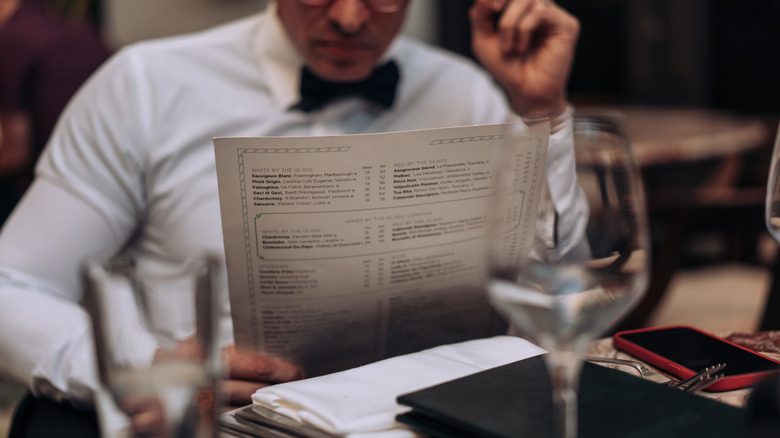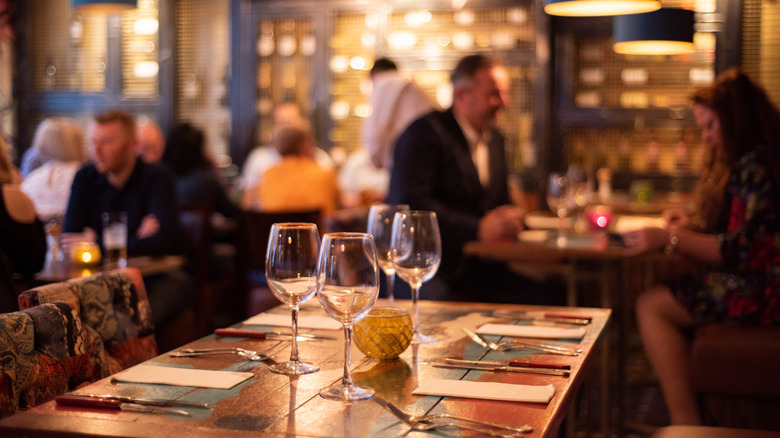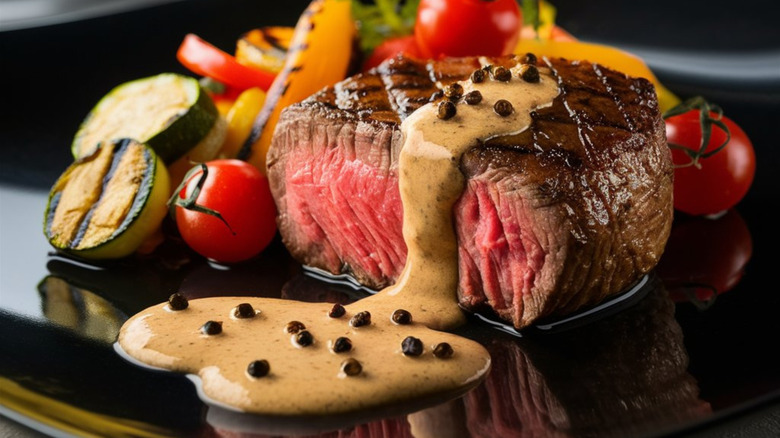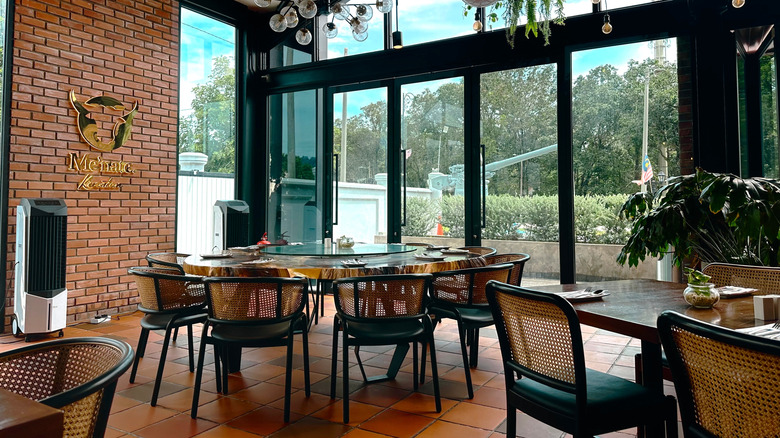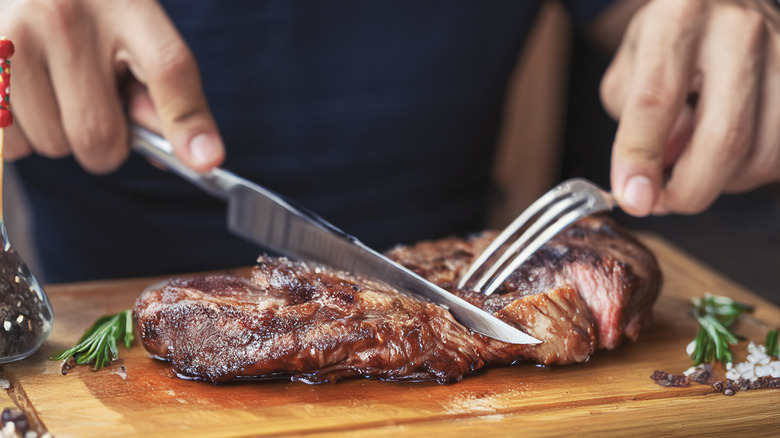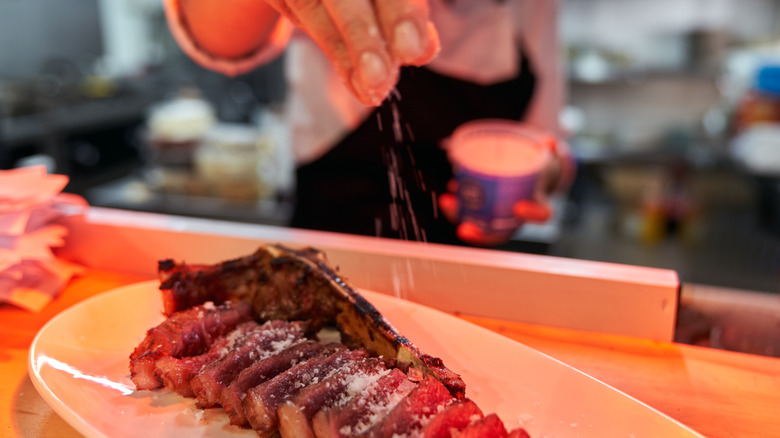A Chef Reveals Tips For How To Have The Best Steakhouse Experience
Going to the steakhouse is, for many, a treat. A dining experience that's typically a little more on the expensive side, you might save it for special occasions, when you get dressed up and go out with your favorite people for an upscale dinner and drinks. As such, you want to have the best steakhouse experience possible. After all, who wants to drop a not unsubstantial amount of their hard-earned cash on a steakhouse dinner, just to walk away thinking that the meal was pretty lackluster at best?
While the restaurant itself obviously plays a big role in ensuring the food and service live up to your expectations, there are also things that you might do as a diner that can either elevate your steakhouse experience or put a damper on things. We spoke to Chef Kylian Goussot, of Miami's Lafayette Steakhouse, as well as gleaned insights from other experts, to get some of tips on what you can do on your end, as the customer, to ensure the best steakhouse experience possible.
Choose the right steak cut
First and foremost, if you're ordering a steak — and since you're at a steakhouse, so you probably are — make sure that you choose the right steak. Most steakhouses will offer several different cuts at various price points and some of these cuts will give you a greater value for the cost, according to Chef Goussot. He recommends opting for cuts that offer both tenderness and flavor, but at a lower menu price, such as ribeye or sirloin. "These cuts are often flavorful and less expensive than premium options like filet mignon, while still offering a great dining experience," he said. Filet mignon, he added, is specifically often overhyped and, while very tender, not as flavorful as other cuts.
Of course, it can also help to know what kind of steak you personally prefer, before you stroll into the steakhouse. For those who like the steak-iest flavor possible, ribeye is often a good choice, but some really like a bone-in steak, such as a T-bone. Some prefer a steak large enough to serve two, such as a porterhouse. Do a little research, look at your chosen restaurant's menu ahead of time, and consider what you might most enjoy, before you're asked to order at dinner, you panic, and order the first thing you see on the steak list.
Ask for your steak to be cooked the right way
You probably know that you shouldn't ask for your steak to be cooked well-done. Critics will cry that a well-done steak is dry, flavorless, a waste of good beef, and no better than chowing down on a piece of tough, thick cardboard. Even the U.S. Department of Agriculture doesn't demand that you cook your steak until well-done, as you might expect for safety reasons; instead, the organization cautions you to cook raw beef steaks to an internal temperature of 145 F, which will place a steak firmly at a medium doneness.
That said, don't just opt for your steak to be cooked to medium, every time you dine. According to Chef Goussot, you should switch up your requested level of doneness depending on the cut of steak you order. For example, if you're opting for a skirt steak or hanger steak, which he says are very affordable, high-flavor cuts, you'll want to order them at rare or medium-rare, for the best flavor.
Avoid certain menu items
Just because you're dining at a nice restaurant, don't assume that everything on the menu is great or a high value. There are certain menu items at steakhouses that just aren't your best bet if you're trying to get the most for your money.
For starters, Chef Goussot recommends, "avoiding items like ground steak or processed meat options, like [a] cheeseburger, if they're overpriced. While they can be tasty, they don't offer the same quality or appeal as a fresh steak cut." Make sure you're picking the right steak sides, too. Popular options that may either fill you up too soon (leaving less room for steak!) or that are often on the blander or disappointing side, no matter your steakhouse of choice, include fries, house rolls, steamed broccoli, and wedge salads.
Likewise, don't drift too far off-menu, either. While small adjustments to a dish may be possible, even fine-dining chefs can't do it all, Anibal Macias, general manager of Michael Mina's Bourbon Steak in Miami, told Mashed in a prior interview.
Visit on the right day of the week
Sure, everyone wants to go out to the fancy steakhouse on a Friday or Saturday night, when you can dine and drink to your heart's content with the happy knowledge that you can sleep in the next day, filled with all that tasty goodness. However, you could get a better deal at a steakhouse if you make your reservations for mid-week (and you'll likely have less trouble getting those reservations, too!).
Chef Goussot said that weekday diners often enjoy discounted menus or fixed-price deals, with specials on Tuesdays and Wednesdays in particular, as these are many steakhouses' slower days. For example, Goussot's Lafayette Steakhouse offers a Butcher Tuesday special for two diners, wherein diners enjoy bread, two sides, a sauce, and the choice of a tomahawk steak or porterhouse steak for $150.
Additionally, beyond just getting a great deal, you may also enjoy fresher food if you visit on a Tuesday or Wednesday rather than a Monday or Thursday–Sunday. Many restaurants receive their weekly meat and seafood delivery on Tuesday.
Skip the steak accoutrements
It's not uncommon for steakhouses to offer a variety of sauces to accompany your steak. Sure, the affordable chain steakhouses might provide the bottled stuff, like A1 or Heinz 57 Sauce, but finer steakhouses often craft their own complimentary sauces, ranging from chimichurri to blue cheese sauce, béarnaise to a peppercorn sauce. However, consider forgoing these sauces.
According to Michael Ollier, senior corporate chef for the Certified Angus Beef brand, who spoke with Mashed in a previous interview, a good steak usually doesn't need any sauce at all. In fact, all it really needs is salt and pepper, and otherwise the steak's flavor can shine on its own. If, though, the steak automatically comes with a sauce chosen by the chef, he said, you might consider keeping it rather than swapping it out for another sauce on the menu. The sauce was likely chosen specifically to bring out the best in that particular cut of steak.
Don't order the house wine
If you admittedly don't know your rosé from your Riesling, or your Malbec from your merlot, but you want to enjoy a glass of wine with your steak dinner, you might be tempted to simply ask for "the house wine." After all, every steakhouse has a house wine, right? Not really, according to Bourbon Steak's Macias. She said in a previous Mashed interview that that's not always the case and asking for this option could make your server's job more difficult (and lead to you getting a wine you won't really enjoy).
So what should you order instead? According to Peggy Kearns Dean, the sommelier at Pacific Standard Prime in Redondo Beach, California, who spoke to Tasting Table, a hearty red like a cabernet or Malbec is a good, classic choice for pairing with a steak, but if you want something lighter, such as to pair with a less-fatty cut of steak, you might opt for a pinot noir. Don't care for red wine? If you'd like a white variety, a chardonnay or white Bordeaux blend is acceptable.
Visit earlier in the day
Just like you can adjust your dinner plans to visit a steakhouse mid-week and enjoy both more affordable and fresher food, you can also adjust your plans on the day of your visit and arrive earlier in the day for both a better experience and potential specials. This doesn't mean you need to eat with the early birds.
Instead, Benjamin Prelvukaj, founder and CEO of Benjamin Restaurant Group in Manhattan, which includes Benjamin Steakhouse, told Mashed that, so long as you come in before 7 p.m., you'll likely have a better experience — including possibly being able to stay at your table much longer than you might if you were to arrive during the dinner rush. About 5:30 p.m. is your best option for a relaxed environment and lesser waits for both a table and food. This time also puts you in prime happy hour period, which usually lasts about 4p.m. to 6 p.m.
Don't be afraid to ask about your steak's quality
Really! Asking questions about a steak's quality before you order isn't an insult to the steakhouse. Instead, it shows that you're an educated diner and you know what you're talking about when you order. In fact, you can even ask to see your steak before it's cooked, even if the restaurant doesn't proudly display its steaks as soon as you walk in, Texas Roadhouse-style.
Not sure what you'd be looking at, even if your waiter did bring out your steak for inspection? No worries. There are some questions you can ask to glean a few pertinent details. For example, ask where the steak is sourced (the more specific an answer you receive, the better, right down to the farm), and also about the steak's grade. A Prime grade is preferred, but Choice is also acceptable, if you want to save a little cash, according to Chef Brad Wise, owner of Trust Restaurant Group in San Diego and Rare Society steakhouse, who commented on the subject in a Mashed article.
Methodology
To compile expert insights for this article, we spoke with Chef Kylian Goussot, of Miami's Lafayette Steakhouse, a restaurant that blends American steakhouse tradition with European sophistication. We also pulled expert tips and advice from previous original interviews offered by the following experts to Mashed and Tasting Table: Anibal Macias, General Manager of Michael Mina's Bourbon Steak in Miami; Michael Ollier, senior corporate chef for the Certified Angus Beef brand; Peggy Kearns Dean, the sommelier at Pacific Standard Prime in Redondo Beach, California; Benjamin Prelvukaj, founder and CEO of Benjamin Restaurant Group in Manhattan, which includes Benjamin Steakhouse; and Chef Brad Wise, owner of Trust Restaurant Group in San Diego and Rare Society steakhouse.
Static Media owns and operates The Takeout, Tasting Table, and Mashed.
